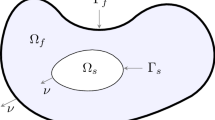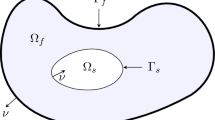Abstract
We consider a heat–structure interaction model where the structure is subject to viscoelastic (strong) damping, and where a (boundary) control acts at the interface between the two media in Neumann-type or Dirichlet-type conditions. For the boundary (interface) homogeneous case, the free dynamics generates a s.c. contraction semigroup which, moreover, is analytic on the energy space and exponentially stable here Lasiecka et al. (Pure Appl Anal, to appear). If \({\mathcal {A}}\) is the free dynamics operator, and \({\mathcal {B}}_N\) is the (unbounded) control operator in the case of Neumann control acting at the interface, it is shown that \({\mathcal {A}}^{-\frac{1}{2}}{\mathcal {B}}_N\) is a bounded operator from the interface measured in the \(\mathbf{L}^2\)-norm to the energy space. We reduce this problem to finding a characterization, or at least a suitable subspace, of the domain of the square root \((-{\mathcal {A}})^{1/2}\), i.e., \({\mathcal {D}}((-{\mathcal {A}})^{1/2})\), where \({\mathcal {A}}\) has highly coupled boundary conditions at the interface. To this end, here we prove that \({\mathcal {D}}((-{\mathcal {A}})^{\frac{1}{2}})\equiv {\mathcal {D}}((-{\mathcal {A}}^*)^{\frac{1}{2}})\equiv V\), with the space V explicitly characterized also in terms of the surviving boundary conditions. Thus, this physical model provides an example of a matrix-valued operator with highly coupled boundary conditions at the interface, where the so called Kato problem has a positive answer. (The well-known sufficient condition Lions in J Math Soc JAPAN 14(2):233–241, 1962, Theorem 6.1 is not applicable.) After this result, some critical consequences follow for the model under study. We explicitly note here three of them: (i) optimal (parabolic-type) boundary \(\rightarrow \) interior regularity with boundary control at the interface; (ii) optimal boundary control theory for the corresponding quadratic cost problem; (iii) min–max game theory problem with control/disturbance acting at the interface. On the other hand, if \({\mathcal {B}}_D\) is the (unbounded) control operator in the case of Dirichlet control acting at the interface, it is then shown here that \({\mathcal {A}}^{-1}{\mathcal {B}}_D\) is a bounded operator from the interface measured this time in the \(\mathbf{H}^{\frac{1}{2}}\)-norm to the energy space. Similar consequences follow.

Similar content being viewed by others
References
Avalos, G., Lasiecka, I., Triggiani, R.: Higher regularity of a coupled parabolic-hyperbolic fluid-structure interactive system. Georgian Math. J. 15(3), 403–437 (2008)
Avalos, G., Triggiani, R.: The coupled PDE-system arising in fluid-structure interaction. Part I: Explicit semigroup generator and its spectral properties (with G. Avalos). AMS Contemp. Math. Fluids Waves 440, 15–55 (2007)
Avalos, G., Triggiani, R.: Uniform stabilization of a coupled PDE system arising in fluid-structure interaction with boundary dissipation at the interface. Discret. Cont. Dyn. Syst. 22(4), 817–833 (2008)
Baiocchi, C.: Un teorema di interpolazione; applicazioni ai problemi ai limiti per le equazioni a derivate parziali. Ann. Math. Pura Appl. 4(LXXIII), 235–252 (1966)
Balakrishnan, A.V.: Fractional powers of closed operators and the semigroups generated by them. Pac. J. Math. 10, 419–437 (1960)
Balakrishnan, A.V.: Applied Functional Analysis. Springer, New York (1981)
Balakrishnan A.V.: Boundary control of parabolic equations, L-Q-R theory, Proceedings of International Summer School, Control Institute Math & Mech. Academy of Sciences, GDR, Gerlin (1977)
Bensoussan, A., Delfour, M.C., Da Prato, G., Mitter, S.K.: Representation and Control of Infinite Dimensional Systems. Birkhauser, Boston (1992)
Canic, S., Mikelic, A., Tambaca, J.: A two-dimensional effective model describing fluid-structure interaction in blood flow: analysis, simulation and experimental validation. Compte Rendus Mech. Acad. Sci. Paris 333(12), 867–883 (2005)
Chen, S., Triggiani, R.: Proof of two conjectures of G. Chen and D. L. Russell on structural damping for elastic systems: the case \(\alpha = 1/2\) (with S. Chen). In: Proceedings of Seminar on Approximation and Optimization, University of Havana, Cuba (January 1987). Lecture notes in mathematics 1354, pp. 234–256. Springer (1988)
Chen, S., Triggiani, R.: Proof of extensions of two conjectures on structural damping for elastic systems: the case \(1/2 \le \alpha \le 1\)). Pac. J. Math. 136, 15–55 (1989)
Chen, S., Triggiani, R.: Characterization of domains of fractional powers of certain operators arising in elastic systems, and applications. J. Differ. Eqns. 88, 279–293 (1990)
Du, Q., Gunzburger, M.D., Hou, L.S., Lee, J.: Analysis of a linear fluid-structure interaction problem. Discret. Dynam. Syst. 9(3), 633–650 (2003)
De Simon, L.: Un’applicazione della teoria degli integrali singolari allo studio delle equazioni differenziali lineari astratte del primo ordine. Rend. del Semin. Mat. Della Univ. di Padova 34, 205–223 (1964)
Fujiwawa, D.: Concrete characterization of the domain of fractional powers of some elliptic differential operators of the second order. Proc. Jpn. Acad. 43, 82–86 (1967)
Grisvard, P.: Caracterization de quelques espaces d’interpolation. Arch. Ration. Mech. Anal. 25, 40–63 (1967)
Ignatova, M., Kukavica, I., Lasiecka, I., Tuffaha, A.: On well-posedness for a free boundary fluid-structure model. J. Math. Phys. 53(11), 115624 (2012)
Ignatova, M., Kukavica, I., Lasiecka, I., Tuffaha, A.: On well-posedness and small data global existence for an interface damped free boundary fluid-structure model. Nonlinearity 27(3), 467–499 (2014)
Kato, T.: Fractional powers of dissipative operators. J. Math. Soc. Jpn. 13(3), 246–274 (1961)
Lasiecka, I.: Unified theory for abstract parabolic boundary problems—a semigroup approach. Appl. Math. Optim. 6, 31–62 (1980)
Lasiecka, I., Lu, Y.: Asymptotic stability of finite energy in Navier Stokes-elastic wave interaction. Semigroup Forum 82(1), 61–82 (2011)
Lasiecka, I., Lu, Y.: Interface feedback control stabilization of a nonlinear fluid-structure interaction. Nonlinear Anal. 75(3), 1449–1460 (2012)
Lasiecka, I., Triggiani, R.: A cosine operator approach to modeling \(L-2\) boundary input hyperbolic equations. Appl. Math. Optimiz. 7, 35–83 (1981)
Lasiecka, I., Triggiani, R.: Control theory for partial differential equations: continuous and approximation theories I. In: Abstract Parabolic Systems Encyclopedia of Mathematics and its Applications Series, Cambridge University Press, Cambridge (2000)
Lasiecka I., Triggiani R.: Control Theory for Partial Differential Equations: Continuous and Approximation Theories II, Abstract Hyperbolic Systems over a Finite Time Horizon Encyclopedia of Mathematics and Its Applications Series, Cambridge University Press, pp. 422 (2000)
Lasiecka, I., Triggiani, R.: Domains of fractional powers of matrix-valued operators: a general approach. In: Arendt, W., Chill, R., Tomilov, Y. (eds.) Operator Theory Advances and Applications, pp. 297–310. Springer, New York (2015)
Lasiecka I., Triggiani R.: Heat-structure interaction with viscoelastic damping: analyticity with sharp analytic sector, exponential decay. Commun. Pure Appl. Anal., to appear
Lebiedzik C., Triggaini R.: The optimal interior regularity for the critical case of a clamped thermoelastic system with point control revisited. In: Ruzhansky, M., Wirth, J. (eds.) Modern Aspects of the Theory of PDEs. Operator Theory: Advances and Applications, vol. 216, pp. 243–259, Birkhäuser/Springer, Basel (2011)
Lions, J.L.: Quelques methods de resolution des problemes aux limits nonlinearies. Dunod, Paris (1969)
Lions, J.L.: Especes d’interpolation et domaines de puissances fractionnaires d’openateour. J. Math. Soc. JAPAN 14(2), 233–241 (1962)
Lions, J.L., Magenes, E.: Nonhomogeneous Boundary Value Propblems and Applications. Springer, New York (1972)
Lu, Y.: Uniform Stabilization to equilibrium of a non-linear fluid-structure interaction model. NONRWA 25, 51–63 (2015)
Martinez, C., Sanz, M.: The Theory of Fractional Powers of Operators, p. 350. North-Holland, Elsevier (2001)
Pazy, A.: Semigroups of Linear Operators and Applications to Partial Differential Equations. Springer, New York (1983)
Triggiani, R.: Lecture notes in control and information sciences. A Cosine Operator Approach to Modeling Boundary Input Problems for Hyperbolic Systems, pp. 380–390. Springer, New York (1978)
R. Triggiani: A matrix-valued generator \({\cal A}\) with strong boundary coupling: a critical subspace of \(D(({-\cal A})^{\frac{1}{2}})\) and \(D(({-\cal A^*})^{\frac{1}{2}})\) and implications. Evolut. Equ. Control Theory. 5(1) (2016)
Washburn, D.: A bound on the boundary input map for parabolic equations with application to time optimal control. SIAM J. Control 17, 652–671 (1979)
Acknowledgments
The author wish to thank the referee. The research of R. T. was partially supported by the National Science Foundation under grant DMS-1434941, and by the Air Force Office of Scientific Research under Grant FA9550-09-1-0459. R. T. thanks the Instytut Badan Systemowych PAN, Warsaw, Poland, for collaboration and hospitality under project UMO-2014/15/B/ST1/00067.
Author information
Authors and Affiliations
Corresponding author
Additional information
In memory of A. V. Balakrishnan: long-time friend, mentor, collaborator.
Rights and permissions
About this article
Cite this article
Triggiani, R. A Heat–Viscoelastic Structure Interaction Model with Neumann and Dirichlet Boundary Control at the Interface: Optimal Regularity, Control Theoretic Implications. Appl Math Optim 73, 571–594 (2016). https://doi.org/10.1007/s00245-016-9348-2
Published:
Issue Date:
DOI: https://doi.org/10.1007/s00245-016-9348-2




